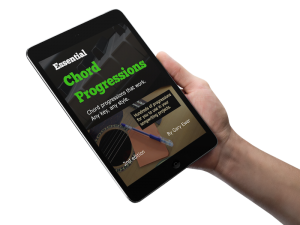On this blog, I find that I often describe chord progressions as being that one element of songs that doesn’t need to be complicated or unique. My main reason for downplaying the need for unique chord progressions is simply this: the more complicated a progression is, the more likely you’ll wind up with one that just doesn’t work.
And since many hit songs have been written using very basic I-IV-V-type progressions, you may be giving yourself bigger headaches than necessary when trying to come up with chords that stray from the norm.
 If you like starting songs by working out chord progressions, you need this eBook: “Writing a Song From a Chord Progression.” It shows you how to avoid the typical problems that can arise from this common songwriting process. Get it separately, or as part of “The Essential Secrets of Songwriting 10-eBook Bundle.”
If you like starting songs by working out chord progressions, you need this eBook: “Writing a Song From a Chord Progression.” It shows you how to avoid the typical problems that can arise from this common songwriting process. Get it separately, or as part of “The Essential Secrets of Songwriting 10-eBook Bundle.”
Having said that, though, there is something to be said for chord progressions that give you moments that are unpredictable. A unique progression can pull the listener’s ear in wonderfully unexpected directions, and as long as the progression works, you’ll be writing a song that sounds wonderfully fresh and creative.
There is another good side effect that comes from developing and using more creative chord progressions: the melodies you write to go with those chords also tend to be creative, imaginative and innovative.
(A few years back I wrote a blog article about writing more creative progressions, and if it’s something you’d like to experiment with, please check out that article: How to Make Stronger, More Creative Chord Progressions.)
How More Creative Chords Help to Create More Interesting Melodies
There’s nothing wrong with allowing your chords to guide what your melodies are going to sound like. The chords-first songwriting process is a time-honoured way of working. But one of the dangers of starting with chords is that the melody can be a bit mundane if you’re not careful.
Of course, the best way to solve that problem is to turn your attention immediately to the melody once you’ve got a good progression.
But here’s another potential problem: since melodies written during a chords-first process mainly tend to use chord tones as a guide, a simple, basic progression might give you a simple, basic melody… not always what you’re wanting.
That’s where a more creative progression can be good, because it can offer better possibilities for your melodies.
If you’re looking to use better, more interesting progressions, but don’t yet feel confident to find them on your own, try the examples below. They all feature interesting moments that stray a bit from basic progressions, but they all still focus in on the tonic chord:
- Am7 Dm7 G Am|A7 Dm Db C (vi7 ii7 V vi|V/ii ii bII I)
- C F Ebadd9 Dm |G7 Abdim Am G13 (I IV bIII9 ii|V7 bVI-dim vi V13)
- Am G F Bb |Eb Dm Dm#11 G (vi V IV bVII |bIII ii ii#11 V)
- C G/B Am F | Fm C/E D7 G (I V6 vi IV |iv I6 V7/V G)
- Am Bb F G13 |Am F Bb Ab (vi bVII IV V13 |vi IV bVII bVI)
So what’s the best way to use these progressions to create better melodies? Try this:
- Start by strumming each chord for two beats, and play the progression over and over.
- As your ear becomes more accustomed to the odd twists and turns in the chords, start humming melodic shapes that work with the chords.
- Make sure the melodies you hum are mainly stepwise (one letter name to an adjacent letter name either up or down), with a few interesting leaps upward or downward.
You’ll notice that these progressions, even though they have odd moments, still target the tonic chord and make it sound like an important anchor. Similarly, a good melody will have interesting, unpredictable moments, but ultimately move away from and back toward the tonic chord.
 Written by Gary Ewer. Follow Gary on Twitter.
Written by Gary Ewer. Follow Gary on Twitter.
 If all you need are tons of progressions to try out, you need “Essential Chord Progressions” and “More Essential Chord Progressions.” They’re both part of “The Essential Secrets of Songwriting 10-eBook Bundle.”
If all you need are tons of progressions to try out, you need “Essential Chord Progressions” and “More Essential Chord Progressions.” They’re both part of “The Essential Secrets of Songwriting 10-eBook Bundle.”










